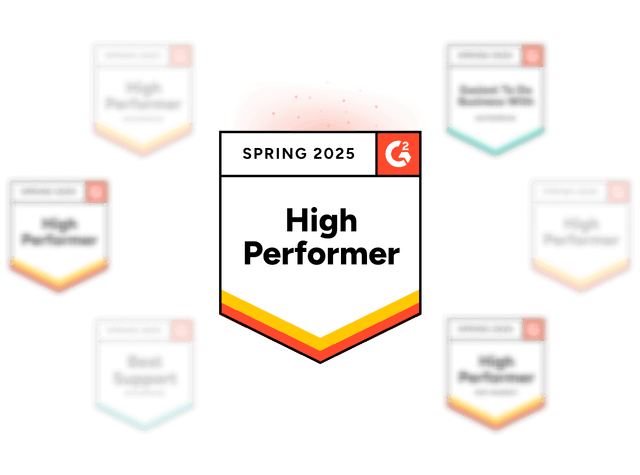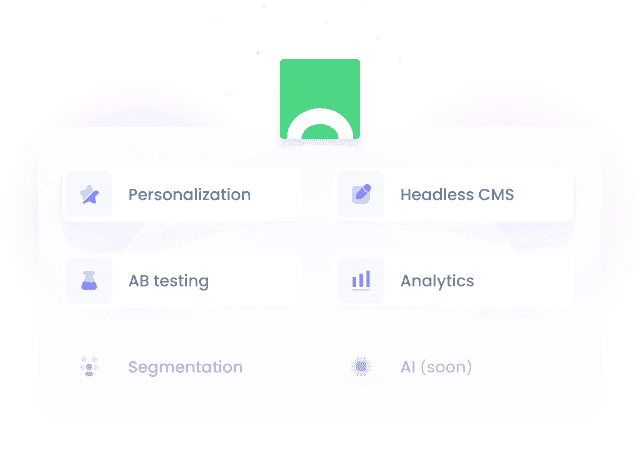Delivering a personalized experience is no longer optional—it's essential. Everybody knows consumers expect content tailored to their preferences, behavior, and needs at every interaction. However, many businesses struggle to meet these demands when relying on traditional headless content management systems.
While these platforms have transformed how we manage and deliver content, particularly for omnichannel experiences, they fall short when it comes to delivering dynamic, personalized content in real time.
Traditional headless CMS platforms were designed with efficiency and flexibility in mind, separating content from the front-end presentation to allow content distribution across multiple channels. However, none of them were built with personalization as a core capability. This means businesses must jump through hoops, often implementing complex workarounds or gluing together multiple tools to achieve even basic levels of personalization.
In this post, we'll explore why traditional headless CMS solutions aren't well-suited for personalization, the typical steps companies take to compensate for this gap, and how a headless CMS built specifically for personalization can complement your existing setup.
Before you ask, I can anticipate you don't need to throw out your entire CMS to deliver personalized content. Instead, we'll show you how CMS for personalization can help you deliver personalized experiences while keeping your current CMS intact—unlocking new possibilities for user engagement and growth.
Make everyone happy with the tools the growth team loves: dynamic content, personalization, AB testing, and analytics.

Why do you need another CMS for personalization?
A traditional headless CMS is fantastic for delivering static, one-size-fits-all content quickly and efficiently across multiple platforms. There are plenty of options in the market like:
However, personalization introduces a whole new layer of complexity. This traditional headless CMS lacks the native ability to deliver tailored content to individual users in real time.
This means that businesses looking to deliver personalized experiences often run into significant roadblocks, such as:
- Static delivery: because these platforms were built to serve static content through APIs, they're usually limited when it comes to the dynamic nature needed for real-time personalization. Any attempt to modify content based on user preferences or behavior requires complex workarounds.
- Data silos: personalization requires data from user behavior, preferences, and interactions. However, traditional headless CMS isn't designed to seamlessly integrate and process this user data in real-time, often requiring separate integrations with tools like CDPs and personalization engines.
- Development complexity: personalizing content through a headless CMS usually means developers have to custom-build solutions or glue together different services (AB testing tools, personalization engines, etc.), increasing the complexity, cost, and time to market.
How to implement personalization with traditional headless CMS
When companies try to personalize content using a traditional headless CMS, they often face several roadblocks that require complex and inefficient workarounds. Here are the most common approaches businesses take to fill the gap, along with examples of how these methods play out in real-world scenarios:
Integrations with external tools
To achieve personalization, companies frequently resort to integrating various third-party tools for tasks like user segmentation, AB testing, and analytics. These tools need to be integrated into the headless CMS, which can be cumbersome, error-prone, and expensive.
For example, a company might use a headless CMS like Contentful to manage their static content, but then they would need to integrate a personalization platform such as Ninetailed for delivering personalized content. This translates to multiple integrations:
- Contentful stores the content.
- Ninetailed handles personalization rules.
- VWO takes care of AB testing.
- Google Analytics tracks user behavior to refine future personalization efforts.
Each tool serves a specific function, but the data and processes are siloed. The lack of a unified platform often results in inconsistent experiences and slow response times, as these systems aren't designed to communicate in real time.
Custom development
Many companies try to overcome these limitations by building their own custom solutions. Developers create tailored logic that pulls data from the CDP, processes it through custom-built personalization engines, pulls the respective content from the headless CMS, and delivers personalized content back to users.
While this might seem like a flexible solution, it's highly resource-intensive and hard to maintain.
For instance, imagine an e-commerce company using Sanity CMS to manage product content. To offer personalized product recommendations, they would need to:
- Build a custom personalization engine that analyzes user browsing behavior and previous purchases.
- Create APIs to pull personalized recommendations into the website alongside static content.
- Ensure the system scales with traffic spikes, such as during Black Friday and end-of-year sales.
This custom approach is often time-consuming and requires constant updates, as the business needs change or new user data becomes available. Furthermore, if the developer who built the system leaves, maintaining or expanding the solution can become a significant challenge.
Client-side personalization
Another common workaround is to push personalization to the client side—meaning the content is served as static from the headless CMS, and personalization is applied in the user's browser after the page has loaded. While this method simplifies backend processes, it leads to poor user experience due to performance issues.
Take, for example, a media company using Storyblok CMS to manage articles. They want to show users personalized article recommendations based on their reading history. Using client-side personalization, the system loads a static page for all users, and only after the page has loaded does JavaScript kick in to personalize the content.
The problem? Users experience delays and often see generic content briefly before it updates to something personalized—this is known as "content flicker."
This flicker not only frustrates users but also negatively impacts site performance, leading to slower load times, higher bounce rates, and lower engagement. It also complicates tracking, as analytics tools often struggle to capture the correct data when content is dynamically swapped after page load.
Multiple landing pages
Some marketers try to mitigate the need for real-time personalization by creating multiple static versions of a landing page, each designed for a different audience segment. This method involves manually segmenting content and then directing users to the appropriate version of the landing page based on the marketing campaign.
For example, a travel company might create different versions of their homepage for users interested in adventure travel, luxury travel, or family-friendly vacations. These versions are stored in the CMS and are only accessed by users coming from a specific marketing campaign.
While this allows for some level of tailored experiences, it's still a static approach that lacks the real-time flexibility of true personalization for organic users. Moreover, this strategy is difficult to scale and maintain as the number of user segments grows.
Separate personalization engines
To avoid client-side delays, some companies choose to use a dedicated personalization engine alongside their traditional CMS. However, this requires yet another integration and the CMS and personalization engine often don't work as seamlessly together as needed.
Imagine a company using Strapi CMS for managing its content but leveraging a separate engine like Dynamic Yield for personalization. While Strapi manages the content, the personalization engine evaluates user behavior and determines which content should be displayed. This introduces additional complexity:
- The company needs to build and maintain the connection between Strapi and Dynamic Yield.
- Both systems need to be regularly updated and maintained.
- Data synchronization issues can arise, leading to mismatches between the content available in the CMS and the personalized experiences being served.
Even though this method can provide more flexibility than client-side personalization, the extra complexity and cost associated with managing multiple platforms make it less than ideal.
Why a headless CMS for personalization is a better solution
All of these workarounds share common drawbacks: they are time-consuming, costly, and difficult to maintain. They often lead to suboptimal user experiences, with slow load times, performance issues, and inconsistent personalization.
What businesses really need is a solution that seamlessly integrates personalization without requiring complex multi-tool integrations or heavy custom development. This is where a headless CMS designed specifically for personalization can step in, offering a better, more scalable approach to delivering personalized content.
When you think about how personalization is used across a website, you may notice that not all of your website elements and components should be personalized. Usually, companies focus their efforts on personalizing only the elements that are most important for conversions and user experience, like menus, banners, cards, forms, etc. Still, most of the website content remains static.
That being said, what if you could avoid all these hurdles for personalization by still using your current CMS for most of the website content and using a headless CMS for the personalized content?
A headless CMS built for personalization has everything you need to deliver dynamic, personalized content without replacing your entire system or worrying about third-party integrations, data collection, performance issues, etc. In short, it can complement your existing setup:
- A headless CMS for personalization can work alongside your traditional CMS. Your existing system can handle static content, while the personalization CMS focuses on delivering dynamic, user-specific content in real time. This combination allows you to keep what works while enhancing the overall user experience.
- With a CMS designed for personalization, businesses can offer tailored content experiences to each visitor without relying on third-party integrations or custom development.
You don't have to replace your entire CMS
One of the biggest concerns for companies is the thought of having to overhaul their entire CMS just to introduce personalization. With a headless CMS for personalization, this isn't necessary. You can keep your traditional CMS for static content management while using the personalization CMS as an additional layer for dynamic content. This hybrid approach allows you to:
- Reduce time to market: instead of spending months rebuilding your entire CMS from scratch, it allows you to integrate personalization without disrupting your current workflows.
- Easily scale: as your business grows, so does the complexity of personalization. the dynamic content API allows you to scale your personalized content delivery without the need for constant updates to your core CMS.
Why having 3 platforms for content management, AB testing, and personalization when you can have a single one?

Why Croct is the best solution for personalized content
Croct is the first headless CMS built for personalization purposes. It offers a headless CMS that goes beyond the basics and is a better solution for companies aiming to deliver personalized content:
- Seamless integration: Croct integrates effortlessly with your existing stack, offering real-time content personalization without the need for complex third-party tools.
- Built-in AB testing and analytics: no need for separate platforms—Croct includes native support for AB testing and real-time analytics, giving you the data you need to optimize your content.
- Developer-friendly: with Croct's SDKs, developers can implement personalization using a simple API in a fraction of the time compared to custom-built solutions.
- Scalability: whether you're just starting out with personalization or need to scale to millions of users, Croct is built to handle personalization at any scale, effortlessly processing billions of data points.
A headless CMS like Croct can work in harmony with your existing CMS, allowing you to offer dynamic, personalized experiences without overhauling your current system.
By the way, we also offer a forever-free account, so if you're ready to take your content personalization to the next level go ahead and try Croct to unlock the power of real-time, dynamic personalization today.